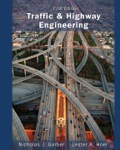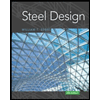
Traffic and Highway Engineering
5th Edition
ISBN: 9781305156241
Author: Garber, Nicholas J.
Publisher: Cengage Learning
expand_more
expand_more
format_list_bulleted
Textbook Question
Chapter 20, Problem 1P
Portland cement concrete consists of what four primary elements?
Expert Solution & Answer
To determine
The four primary elements of Portland cement concrete.
Explanation of Solution
The four primary elements of Portland cement concrete are,
- Portland Cement Portland cement is produced by crushing and pulverizing a cautiously prepared mix
- Coarse Aggregates The coarse aggregates are used in Portland cement concrete are materials of inert that are not going to react with cement and normally are comprised of gravel, which is crushed, stone, or blast furnace slag.
- Fine Aggregates Sand is majorly used in the fine aggregate in Portland cement concrete. for this material the specifications usually include requirements of grading, cleanliness and soundness.
- Water The major water requirement stipulated is that the water used also should be capable fordrinking. This water is needed for the quantity of organic matter, acids, oil, and alkalis should not be higher than the allowable amount in drinking water.
of limestone, marl, and clay and by burning all the mixture at a highest temperature
(about
Want to see more full solutions like this?
Subscribe now to access step-by-step solutions to millions of textbook problems written by subject matter experts!
Students have asked these similar questions
E
D
(B)
(<)
2945
3725
250
2225
Car
Port
5000
2500
Pool
Area
2
3925
3465
2875
13075
Staff Room
Bar Counter
1
GROUND FLOOR PLAN
SCALE
1:100
Hallway
3
1560
4125
3125
$685
Laundry & Service
Area
5
A
Common
T&B
Kitchen &
Dining Arear
B
Living Area
2425
Terrace
E
2
12150
1330
2945
4150
5480
1800
3725
1925
3800
3465
2
3
9150
4125
3575
3925
Terrace
Toilet &
Bathroom
Toilet
Bathroom
Bedroom 1
Bedroom 2
SECOND FLOOR PLAN
SCALE
Hallway
1:100
OPEN TO
BELOW
E
B
A
3
3725
2150
1330
2945
5480
4150
1925
⑨
2
9150
3800
4125
3465
3575
3925
Terrace
R
Toilet &
Bathroom
Toilet &
Bathroom
SECOND FLOOR PLAN
SCALE
Hallway
1:100
OPEN TO
BELOW
+
Q2/
In a design of a portable sprinkler system, the following information is given:
•
•
The sprinklers are distributed in a square pattern with radius of the wetted circle of
the sprinkler=15 m
Consumption rate = 10 mm/day
Efficiency of irrigation = 60%
Net depth of irrigation (NDI)= 80 mm.
Find the following:
1-Sprinkler application rate if HRS = 11.
2-Number of pipes required for irrigation.
(50 Marks)
3-Discharge of sprinkler, diameter of nozzle, and the working head pressure if C=0.90.
4-Diameter of the sprinkler pipe for Slope=0.
5-Pressure head at the inlet and at the dead end of the sprinkler pipe for Slope=0.
(F² + L²)((SF)² + L²)
L²
2L² ≤ D²
L² + S² ≤ D²
A, = * 1000
S*L
≤D²
N W
Af
m-11-P L'
Hf
= 1.14*109 *
1.852 *
L
*F,where c=120
D4.87
Source
main pipe
180 m
540 m
N
1
1 √m-1
F =
im/Nm+1
=
+
+
m+1
2N
6N2
i=1
Nozzle diameter (mm)
3< ds 4.8
4.8< ds 6.4
6.4
Miniatry of Higher
scent Research
University of Ke
Faculty of Engineering
Cell Engineering Department
2024-2025
Mid Exam-1 st Attempt
Time
Date: 17/04/2025
Notes: Answer all questions. Not all figures are to scale. Assume any values if you need them.
Q1/ A farm with dimensions and slopes (50 Marks)
=
shown in the figure below. If you asked
to design a border irrigation system and
if you know that Net depth of irrigation
- 96mm .Manning coefficient = 0.15,
Time of work in the farm is 6
hours/day. Design consumption use of
water from the crop (ET) 16 mm/day,
Width of the agricultural machine equal
to 2.5m, Equation of infiltration - D=
12-05 and Efficiency of irrigation=
60%. You can neglect the recession lag
time. Find the width and number of the
borders, Irrigation interval and time
required to irrigate the whole farm,
Depth of flow in the inlet of border
Number of borders that irrigated in one
day and The neglected recession lag
time
Slope of irrigation %
Maximum border width
0-0.1
30…
Chapter 20 Solutions
Traffic and Highway Engineering
Ch. 20 - Portland cement concrete consists of what four...Ch. 20 - List and briefly describe the five main types of...Ch. 20 - What is the main requirement for the water used in...Ch. 20 - Prob. 4PCh. 20 - Prob. 5PCh. 20 - Prob. 6PCh. 20 - Prob. 7PCh. 20 - Prob. 8PCh. 20 - Prob. 9PCh. 20 - Prob. 10P
Ch. 20 - Prob. 11PCh. 20 - Prob. 12PCh. 20 - Repeat Problem 20-12, with the slab containing...Ch. 20 - Prob. 14PCh. 20 - Prob. 15PCh. 20 - Prob. 16PCh. 20 - Prob. 17PCh. 20 - Prob. 18PCh. 20 - An existing rural 4-lane highway is to be replaced...Ch. 20 - Prob. 20PCh. 20 - Prob. 21PCh. 20 - Prob. 22PCh. 20 - Prob. 23PCh. 20 - Prob. 24PCh. 20 - Prob. 25PCh. 20 - Prob. 26PCh. 20 - Prob. 27P
Knowledge Booster
Learn more about
Need a deep-dive on the concept behind this application? Look no further. Learn more about this topic, civil-engineering and related others by exploring similar questions and additional content below.Similar questions
- PLease make sure to show all work and all steps for the image find the magnitude and stressesarrow_forwardShowing all work and steps find the magnituded and stress ,arrow_forwardWhat is the value of the influence line for the reaction at support A for the beam shown at 5 m to the right of A? Select the reaction at support B to be the redundant. a. 0 kN b. -0.167 kN c. 0.425 kN d. 1.0 kNarrow_forward
- Determine the force in member AB of the truss shown due to a temperature drop of 25°C in Members AB, BC, and CD and a temperature increase of 60°C in member EF. Use the method of consistent deformations. a. 37.34 k b. 0 k c. 28 k d. 46.67 karrow_forwardWhat is the approximate axial force in girder EF of the frame shown? Use the portal method. a. 32 kN b. 60 kN c. 12 kN d. 20kNarrow_forwardDetermine the vertical reaction at C for the beam shown and support settlements of 1" at B and ¼" at C. a. 27.0 k b. 28.3 k c. 43.7 k d. 21.0 karrow_forward
- What is the horizontal reaction component at D for the frame shown? a. 75.00 kN b. 91.67 kN c. 70.31 kN d. 4.69 kNarrow_forwardFind the vertical reaction at D for the frame shown and a settlement of 50 mm at support D. a. 80.7 kN b. 112.5 kN c. 144.3 kN d. 6.51 kNarrow_forwardDetermine if the W14x 22 beam will safely support a loading of w= 1.5 kip/ft. Theallowable bending stress is oallow = 22 ksi and the allowable shear stress is Tallow = 12 ksi.arrow_forward
- What is the fixed end moment FEMAB for the beam shown with a settlement of 1.2 in. at support B? a. -102.7 ft-k b. -95.2 ft-k c. -307.7 ft-k d. 279.8 ft-karrow_forwardSuggest an optimum footing size and shape (minimum area footing), if the vertical loading (includingthe weight of the footing) is 40 kips, and the soil has the following characteristics: c=200 psf, φ=370,and γ=120.0 lb/ft 3. Constraints of the solution are: the maximum dimension of any side of thefooting is 10 ft, and the depth of embedment is between 2 and 4 ft.arrow_forward15.6 A mountain stream flows over a rocky streambed. Apply the Limerinos and Chezy equations to calculate the discharge. The stream has an intermediate rock size d 84 of 30 cm, an average depth of 2.1 m, a slope of S = 0.0037, and a width of 52 m. In SI units, what is the discharge? a. 85, b. 120, c. 160, d. 240, or e. 410.arrow_forward
arrow_back_ios
SEE MORE QUESTIONS
arrow_forward_ios
Recommended textbooks for you
 Traffic and Highway EngineeringCivil EngineeringISBN:9781305156241Author:Garber, Nicholas J.Publisher:Cengage Learning
Traffic and Highway EngineeringCivil EngineeringISBN:9781305156241Author:Garber, Nicholas J.Publisher:Cengage Learning Construction Materials, Methods and Techniques (M...Civil EngineeringISBN:9781305086272Author:William P. Spence, Eva KultermannPublisher:Cengage Learning
Construction Materials, Methods and Techniques (M...Civil EngineeringISBN:9781305086272Author:William P. Spence, Eva KultermannPublisher:Cengage Learning Fundamentals Of Construction EstimatingCivil EngineeringISBN:9781337399395Author:Pratt, David J.Publisher:Cengage,
Fundamentals Of Construction EstimatingCivil EngineeringISBN:9781337399395Author:Pratt, David J.Publisher:Cengage, Materials Science And Engineering PropertiesCivil EngineeringISBN:9781111988609Author:Charles GilmorePublisher:Cengage Learning
Materials Science And Engineering PropertiesCivil EngineeringISBN:9781111988609Author:Charles GilmorePublisher:Cengage Learning Architectural Drafting and Design (MindTap Course...Civil EngineeringISBN:9781285165738Author:Alan Jefferis, David A. Madsen, David P. MadsenPublisher:Cengage Learning
Architectural Drafting and Design (MindTap Course...Civil EngineeringISBN:9781285165738Author:Alan Jefferis, David A. Madsen, David P. MadsenPublisher:Cengage Learning Steel Design (Activate Learning with these NEW ti...Civil EngineeringISBN:9781337094740Author:Segui, William T.Publisher:Cengage Learning
Steel Design (Activate Learning with these NEW ti...Civil EngineeringISBN:9781337094740Author:Segui, William T.Publisher:Cengage Learning

Traffic and Highway Engineering
Civil Engineering
ISBN:9781305156241
Author:Garber, Nicholas J.
Publisher:Cengage Learning

Construction Materials, Methods and Techniques (M...
Civil Engineering
ISBN:9781305086272
Author:William P. Spence, Eva Kultermann
Publisher:Cengage Learning

Fundamentals Of Construction Estimating
Civil Engineering
ISBN:9781337399395
Author:Pratt, David J.
Publisher:Cengage,

Materials Science And Engineering Properties
Civil Engineering
ISBN:9781111988609
Author:Charles Gilmore
Publisher:Cengage Learning

Architectural Drafting and Design (MindTap Course...
Civil Engineering
ISBN:9781285165738
Author:Alan Jefferis, David A. Madsen, David P. Madsen
Publisher:Cengage Learning

Steel Design (Activate Learning with these NEW ti...
Civil Engineering
ISBN:9781337094740
Author:Segui, William T.
Publisher:Cengage Learning
What is Concrete?; Author: Practical Engineering;https://www.youtube.com/watch?v=UOHURuAf5iY;License: Standard Youtube License